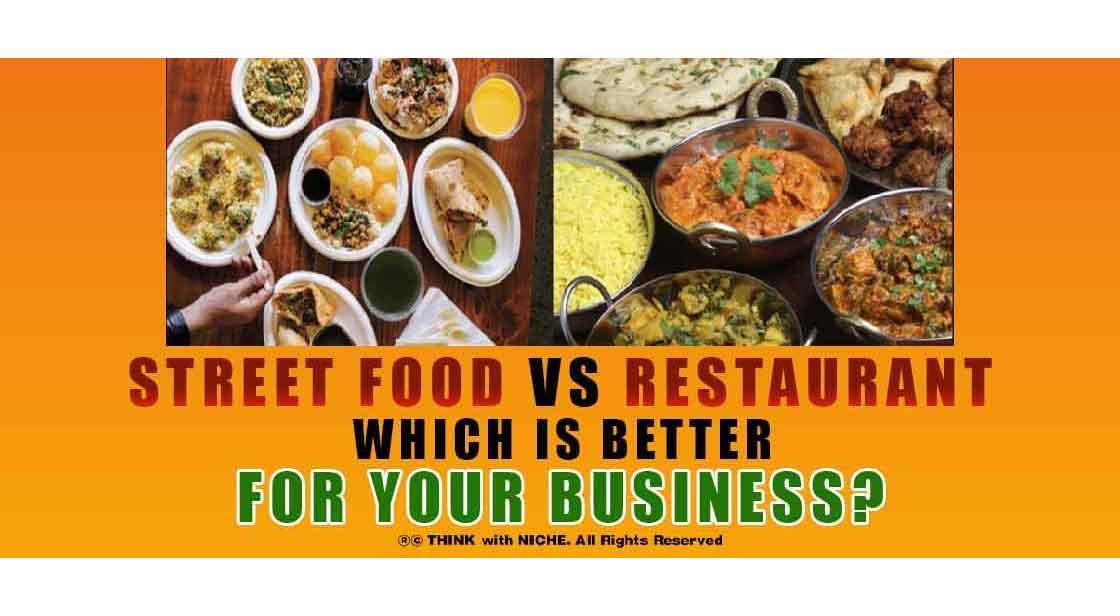Street Food vs Restaurant - Which is Better for Your Business?

Blog Post
Street food is a great option if you want to cook your food and have it delivered to your door. Owning a restaurant has its perks over the street food business. However, the owners of both fields must be aware of the perks associated with each business. The decision between starting a street food business or a restaurant depends on various factors such as cost, convenience, customer base, regulations, branding, menu, flexibility, competition, and seasonality. Both options have their advantages and disadvantages, such as lower start-up costs and flexibility for street food, and higher profit margins and a more upscale dining experience for restaurants. Ultimately, businesses should consider their goals and resources before making a decision, and be prepared to adapt to changes in the market and customer preferences over time.
If you’re running a restaurant, you might be thinking about how to make the most of your profits. Street food, on the other hand, is a great option for people who want to cook their food and have it delivered to their customers. However, restaurant owners should be aware that there are several benefits to cooking street food instead of going to a restaurant. For one, restaurants can often cost more than cooking food from scratch. Additionally, restaurants can be difficult to manage and tend to be more stressful than cooking from scratch. Finally, restaurants often have high prices for food that isn’t as great as food cooked from scratch.
Street Food vs Restaurant - Which is Better for Your Business?
Why Street Food is Better than Restaurant Food
While you should keep some of the advantages of a restaurant like a convenience and quality of food, you should be aware that there are several reasons why street food is better than restaurant food.
It’s affordable!
One of the biggest advantages of street food is its affordability. You can often buy a dozen eggs or meatballs at your local market for less than $5. Additionally, people can eat street food at their own kitchen table rather than spending money on expensive seats or tables. It is means that the cost per person is generally less than a sit-down meal at a restaurant if you're strictly cooking from scratch.
The Different Types of Street Food
Street food differs from other types of food in that it’s usually cooked at street level, not at a restaurant. It is typically served with little or no preparation and doesn’t require refrigeration.
For example, you might be able to find street food like tacos, burritos, and tamales at a local taco stand or a local convenience store. You can also buy street food at a local grocery store or deliver fresh ingredients to your home. Though you may have noticed that some of these foods are called “street food” or “fast food.” It is actually the wrong name. Street foods are often sold for a higher price than fast foods because they are prepared directly on the premises using fresh ingredients (versus frozen dough). Also, many restaurants don't serve these items as regularly as fast foods.
How to Cook Street Food the Right Way
If you cook your own food, you know exactly what ingredients go into it and how much they will cost. You can control the quality of the ingredients that you use while also controlling what portion sizes are sold at a specific store. Most importantly, if you cook your own food, you get to enjoy it just as it should be enjoyed: with friends and family around.
The Benefits of Cooking from scratch at Home
Having a homemade meal at home is one of the best ways to save money and enjoy your time with your family. A homemade meal can be as simple as making a sandwich or serving pasta, and it’s often much healthier than eating out. Additionally, by cooking from scratch at home, you can save on food costs. The first thing to consider is that restaurants usually have higher prices for food than homemade meals. For example, a French sauté chicken entrée at a restaurant may cost $12, whereas a homemade chicken dish could cost between $3 and $5. It may not seem like such a big difference until you compare it to the amount of food in one meal versus two meals bought at fast-food restaurants. When families go out to eat together they often buy extra food to share which results in them paying more per person than if they had bought their own meals instead. When families buy their own food, they can just sit down together and enjoy their meal without having to worry about how many pieces of bread they need or how much butter they will need next.
Save Money on Your Menu and Ingredients
When you cook from scratch, you know exactly what to use for your food and how to prepare it. But that doesn’t mean that you need to buy a bunch of expensive ingredients. You can easily save money on your menu and ingredients by cooking street food. You don’t have to eat at restaurants all the time. If you’re thinking about running a restaurant, there are plenty of options out there — fast food joints and coffee shops are just a couple of choices. However, if you want to cook at home instead of going out, it pays off in many different ways! You’ll save money with fewer calories (less processed foods) and more fresh produce (food grown in your own garden). You can also create new dishes without having to go through the trouble of getting ready-made meals or buying premade recipes for every meal.
Enjoy More Delicious Foods with No Extra Work
The main benefit of cooking food from scratch is that you can enjoy more delicious foods. You don’t have to spend a lot of money on expensive ingredients when you cook from scratch. When you go to the store and buy your food, the foods are already pre-prepared and packaged. Cooking from scratch allows you to make fresh, flavorful food with little effort. You can also save money on groceries because you can use fresh produce instead of buying pre-packaged items like fruit and vegetables. Additionally, restaurant owners should note that preparing food from scratch means they have time to do other things like sleep, exercise, or play with their children after work.
Also Read : Best Ice Cream Brands In The World
A comparative analysis of street food vs. restaurant
When it comes to the food industry, there are two main options for businesses to choose from: street food and restaurant. While both have their advantages and disadvantages, it ultimately comes down to the individual business and what they want to achieve.
Here is a comparative analysis of street food vs. restaurant and which is better for your business:
1. Costs:
Starting a street food business is typically less expensive than opening a restaurant. With street food, you have the option of using a food truck or a food cart, which can be rented or bought at a lower cost than renting or buying a physical space for a restaurant. Additionally, street food businesses usually require fewer staff, resulting in lower labor costs.
However, while the initial cost of opening a restaurant may be higher, restaurants often have higher profit margins than street food businesses in the long run. This is because restaurants can serve a larger volume of customers and can charge higher prices for their dishes.
2. Convenience:
Street food is generally more convenient than restaurants because it's mobile. Food trucks and carts can travel to different locations and events, which allows businesses to reach a wider audience. Street food is also popular with people who are on the go and don't have time to sit down for a meal.
On the other hand, restaurants provide a more traditional dining experience with a comfortable atmosphere and the ability to sit down and enjoy a meal. Restaurants are also able to offer a wider variety of menu items and are not limited by the size of their mobile kitchen.
3. Customer Base:
Street food businesses attract a more diverse customer base than restaurants. They often cater to people who are looking for a quick and convenient meal, such as students, workers, and tourists. Street food businesses also have the advantage of being able to serve customers in areas where restaurants may not be available.
Restaurants, on the other hand, tend to attract a more upscale customer base. They often cater to people who are looking for a more formal dining experience and are willing to pay higher prices for quality food and service.
4. Regulations:
Street food businesses are subject to more regulations and restrictions than restaurants. They must comply with health and safety regulations, obtain permits and licenses, and may be limited in where they can park or set up their food cart or truck. Restaurants are also subject to health and safety regulations, but they are usually able to operate in a fixed location with less restrictions.
5. Branding:
Restaurants have the advantage of being able to establish a strong brand image and reputation. They can create a unique atmosphere and menu, and can use marketing tactics such as social media and advertising to attract customers. Street food businesses, on the other hand, may have a harder time establishing a brand image, as they are often limited by the size of their mobile kitchen and the types of events they can attend.
6. Menu:
Street food businesses often specialize in a specific type of food or cuisine, which can be an advantage in terms of standing out from the competition and attracting a specific customer base. Additionally, street food menus tend to be simpler and more focused, which can lead to faster preparation times and more efficient service.
Restaurants, on the other hand, are able to offer a wider variety of menu items, including more complex and time-consuming dishes. This can be an advantage in terms of appealing to a wider range of customers and providing a more diverse dining experience.
7. Flexibility:
Street food businesses are often able to adapt more quickly to changing market trends and customer preferences. Because they have a smaller and more mobile operation, they can experiment with new menu items or adjust their prices and offerings more easily.
Restaurants, on the other hand, may have a harder time adapting to changes in the market, as they have a more fixed operation and may be limited by their physical space or equipment. However, restaurants also have the advantage of being able to offer more consistent and predictable service and quality.
8. Competition:
Street food businesses may face more competition than restaurants, as there are often many food trucks and carts operating in a given area. This can make it harder to stand out and attract customers, and may require businesses to be more creative and innovative in their marketing and menu offerings.
Restaurants, on the other hand, may have a more established customer base and face less direct competition from other businesses. However, they may still face competition from other types of food establishments, such as fast food chains or gourmet cafes.
9. Seasonality:
Street food businesses may be more affected by seasonality than restaurants, as they are often dependent on outdoor events and festivals for business. This can lead to fluctuations in revenue and may require businesses to be more strategic in their planning and scheduling.
Restaurants, on the other hand, are less affected by seasonality and can usually rely on a steady stream of customers throughout the year. However, they may still need to adjust their menu and offerings based on seasonal ingredients and customer preferences.
Conclusion
The decision of whether to start a street food business or a restaurant depends on the individual business and what they want to achieve. Street food businesses may be more cost-effective and convenient, while restaurants may offer a more upscale dining experience and higher profit margins. Ultimately, it's important for businesses to carefully consider their goals and resources before making a decision.
You May Like
EDITOR’S CHOICE












